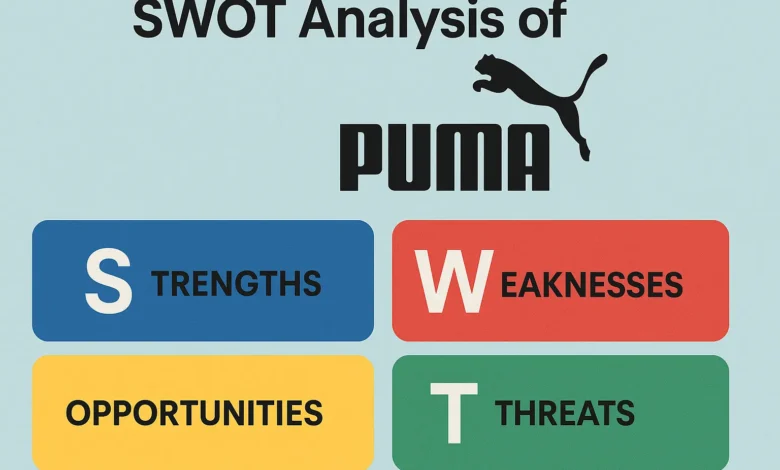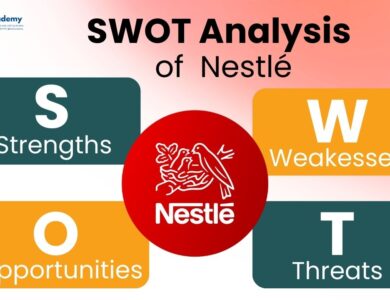Complete SWOT Analysis of Puma – A Deep Dive into the Global Sportswear Brand
"Analyze Puma’s position in the sportswear market with a comprehensive SWOT breakdown—highlighting its innovative edge, market challenges, and brand potential worldwide."

Puma’s journey—from crafting high‑performance track spikes in post‑war Germany to becoming a global sportswear powerhouse—is a masterclass in brand evolution.
Today, Puma’s offerings span performance footwear, athletic apparel, and fashion accessories, driven by high‑profile collaborations with icons like Rihanna, Balmain, and partnerships with Manchester City and Ferrari.
Its digital‑first approach and agile supply chain have helped Puma capture both athletes and streetwear enthusiasts alike.
In this article, we’ll dive deep into Puma’s Strengths, Weaknesses, Opportunities, and Threats (SWOT analysis) to uncover how the brand leverages its heritage, tackles challenges, and seizes growth avenues.
Understanding Puma’s strategic moves offers valuable insights into athleisure trends, celebrity‑driven hype, and the competitive dynamics shaping the global sportswear industry.
Also Read: Complete SWOT Analysis of Uber: How It Dominates the Global Mobility Market
Company Overview – About Puma
Founded in 1948 by Rudolf Dassler, Puma originated in Herzogenaurach, Germany, after a split from his brother Adolf Dassler—who went on to found Adidas.
Since then, Puma has evolved into one of the world’s top three sportswear brands, with a presence in over 120 countries and a reputation for combining performance innovation with bold street style.
Puma’s core business focuses on footwear, apparel, and accessories, targeting both professional athletes and fashion-forward consumers. With revenue crossing €6.8 billion in 2023, the brand has carved a niche by embracing youth culture, pop culture collaborations, and lifestyle marketing.
Its ability to blend sport and fashion has made Puma a strong contender in categories like running, training, soccer, motorsport, and sneaker culture.
Puma’s competitive edge lies in its design agility, celebrity partnerships, and growing emphasis on sustainability through its “Forever Better” program. With a renewed focus on digital transformation and direct-to-consumer sales, Puma continues to push boundaries in the ever-evolving global sportswear market.
What is SWOT Analysis?
A SWOT analysis is a powerful strategic planning tool used by businesses to assess their internal strengths and weaknesses as well as external opportunities and threats. It provides a 360-degree view of where a company stands in the market and helps guide decision-making, brand positioning, and long-term growth strategy.
- S – Strengths: Internal attributes that give the company a competitive advantage (e.g., strong brand identity, innovation, loyal customer base).
- W – Weaknesses: Internal limitations that may hinder growth or efficiency (e.g., limited market share, lower profit margins).
- O – Opportunities: External factors the company can capitalize on (e.g., emerging markets, new product categories, shifting consumer trends).
- T – Threats: External risks that could impact the brand (e.g., competition, market volatility, regulatory changes).
In the case of Puma, SWOT analysis helps us understand how the brand maintains relevance in a highly competitive sportswear industry dominated by giants like Nike and Adidas, while also identifying areas where it can improve and scale globally.
Puma’s Strengths
Puma’s position as one of the top three global sportswear brands isn’t accidental—it’s the result of decades of strong branding, innovation, and strategic positioning. Let’s take a look at the key strengths that fuel Puma’s continued success:
1. Strong Brand Heritage and Recognition
With a legacy dating back to 1948, Puma enjoys strong global brand recall, especially in Europe, Asia, and Latin America.
The iconic leaping cat logo and “Forever Faster” slogan resonate with both athletes and trend-conscious youth. This rich history and cultural connection give Puma instant credibility and loyalty across generations.
2. Product Innovation and Design Agility
Puma’s innovation spans both performance and lifestyle segments. From running shoes with IGNITE Foam and NITRO technology to fashionable collabs like RS-X and Suede sneakers, Puma balances tech and trend exceptionally well.
Its design agility allows quick responses to changing fashion cycles—an area where many legacy sports brands struggle.
3. High-Profile Collaborations & Endorsements
Puma has made a name for itself by aligning with global icons like Rihanna (FENTY Puma), Selena Gomez, Neymar Jr., and Usain Bolt. These partnerships enhance its cultural relevance, especially among Gen Z and millennials, and help position the brand beyond sports into fashion and entertainment.
4. Fast Time-to-Market & Trend Responsiveness
Puma’s relatively lean structure enables it to bring new collections to market faster than some of its larger competitors. This fast-fashion capability gives it an advantage in responding to short-term trends, pop culture moments, and seasonal demands—particularly in the lifestyle sneaker space.
5. Digital & Direct-to-Consumer (D2C) Focus
Puma has been investing heavily in e-commerce, mobile apps, and social media marketing, enabling a stronger connection with consumers. Its D2C strategy not only boosts margins but also provides deeper consumer insights, driving personalized experiences and targeted campaigns.
6. Commitment to Sustainability
Through its “Forever Better” campaign, Puma is making strides in sustainable product innovation and ethical manufacturing. From recycled materials to carbon transparency and zero-plastic initiatives, the brand is aligning with the values of eco-conscious consumers and positioning itself as a responsible leader in the industry.
Also Read: Complete SWOT Analysis of Titan – India’s Leading Watch and Jewelry Brand
Puma’s Weaknesses
While Puma has built a strong global presence, it still faces several internal limitations that affect its ability to scale, differentiate, and maximize profitability. Identifying these weaknesses is key to understanding where the brand can improve and how it stacks up against bigger rivals.
1. Smaller Scale Compared to Competitors
Puma operates on a much smaller scale than industry giants like Nike and Adidas. This limits its research and development budget, marketing power, and global influence. As a result, Puma often plays catch-up in launching breakthrough technologies or sponsoring elite athletes and teams on the same scale as its larger rivals.
2. Brand Positioning Challenges
Puma straddles the line between performance sportswear and fashion lifestyle, which can sometimes create confusion in consumer perception.
While Nike and Adidas have clearer category separation (e.g., performance vs. Originals), Puma’s identity may come across as inconsistent or less focused—especially for consumers seeking performance credibility.
3. Overdependence on Collaborations
Although Puma’s celebrity and designer partnerships generate hype, they can also create short-term buzz rather than long-term brand equity. Relying too heavily on limited drops or influencer-driven sales can lead to volatility and weaken core product performance if not balanced with consistent innovation.
4. Profit Margin Pressures
Puma’s fast-fashion approach, frequent discounting, and the cost of high-profile endorsements can erode profit margins. The brand often relies on volume-based growth, which may not be sustainable in regions facing economic downturns or where competition is heavy on pricing.
5. Underpenetration in Emerging Markets
While Puma performs well in Europe and parts of Asia, it still lags in emerging markets like India, Africa, and parts of South America—regions with fast-growing youth populations and rising disposable incomes.
Without aggressive localization and deeper retail networks, Puma risks falling behind competitors that are already expanding aggressively in these areas.
Also Read: Complete SWOT Analysis of Swiggy – India’s Leading Food Delivery Service
Puma’s Opportunities
The global sportswear and athleisure industry is rapidly evolving, offering brands like Puma several high-potential growth opportunities. By leveraging current market trends, consumer behaviors, and digital advancements, Puma can enhance its global presence and profitability.
1. Expansion in Emerging Markets
Countries in Asia-Pacific, Africa, and Latin America are experiencing a surge in youth populations, urbanization, and fitness culture.
Puma has a chance to deepen its presence in these fast-growing regions by launching localized products, forming strategic retail partnerships, and investing in regional influencers and sports sponsorships.
2. Growth in Women’s and Youth Segments
The women’s activewear market is booming, driven by demand for fashionable yet functional sportswear. Puma’s past success with collections led by Rihanna and Selena Gomez shows the power of targeting female consumers.
There’s also untapped potential in the Gen Z demographic, which is highly engaged with streetwear, social media, and sustainability—areas where Puma already has a strong foothold.
3. Scaling Direct-to-Consumer and Omnichannel Retail
Puma can continue scaling its D2C model by enhancing its e-commerce platforms, integrating mobile-first experiences, and building flagship brand stores in key cities. Strengthening its omnichannel capabilities—like click & collect, virtual try-ons, and seamless app integration—can improve customer experience and boost margins.
4. Sustainability-Driven Product Innovation
Eco-conscious consumers are prioritizing brands that demonstrate clear action on climate change, recycled materials, and ethical labor. Puma’s “Forever Better” platform can be expanded to launch sustainable collections, eco-friendly packaging, and transparency in sourcing, positioning the brand as a true leader in ethical fashion.
5. Capitalizing on the Health & Wellness Boom
The global shift towards active lifestyles, home workouts, and mindful living opens the door for Puma to expand into yoga wear, home fitness gear, and athleisure crossover products. Developing gear suited for both performance and relaxation can strengthen Puma’s position in the everyday wear space.
6. Strategic Partnerships & Tech Integration
Puma can explore partnerships with tech firms or startups to integrate smart features into footwear and apparel (e.g., fitness tracking, app connectivity). Collaborations with local artists, esports influencers, and fitness communities could also help Puma stay culturally relevant and attract new audiences.
By actively pursuing these opportunities, Puma can continue growing beyond its current reach—capturing new audiences, increasing revenue streams, and solidifying its position as a top contender in global sportswear.
Also Read: Complete SWOT Analysis of Patanjali – India’s Leading Ayurvedic Brand
Puma’s Threats
Even with strong momentum and global recognition, Puma faces several external threats that could challenge its position in the highly competitive sportswear and fashion industries. Navigating these risks effectively will be crucial for its long-term growth and brand sustainability.
1. Intense Market Competition
Puma competes with global giants like Nike, Adidas, and Under Armour, all of which have larger R&D budgets, deeper distribution networks, and more aggressive marketing.
Additionally, fast-fashion brands such as Zara and H&M are entering the athleisure space, putting pressure on Puma’s pricing, innovation, and speed-to-market strategies.
2. Economic Slowdowns and Consumer Spending
As a lifestyle and performance brand, Puma’s products are often considered non-essential or premium purchases. In times of economic uncertainty, like inflation or recession, consumers may shift spending toward lower-priced or local alternatives, affecting Puma’s sales volumes and profitability—especially in price-sensitive markets.
3. Global Supply Chain Disruptions
Puma relies heavily on a global manufacturing and logistics network. Factors like geopolitical tensions, rising fuel costs, pandemic-related delays, or natural disasters can disrupt the supply chain, increase lead times, and raise production costs—potentially impacting inventory and delivery commitments.
4. Rapidly Evolving Consumer Preferences
Trends in sportswear and fashion shift rapidly. If Puma fails to keep up with changing preferences in design, functionality, sustainability, or digital shopping experiences, it risks losing relevance among younger and more demanding consumer groups like Gen Z.
5. Counterfeit Products and Brand Dilution
Puma is one of the most counterfeited sportswear brands in markets like India, China, and Southeast Asia. The rise of unregulated e-commerce platforms has made it easier for counterfeit goods to reach consumers, damaging brand perception and revenue while increasing legal and enforcement costs.
6. Pricing Pressure and Discount Wars
To stay competitive, Puma often offers discounts and participates in flash sales. This can result in price wars with competitors and create an expectation of frequent markdowns, which can hurt long-term brand equity and reduce customer lifetime value.
Puma must continue to monitor these threats proactively, adapt to industry shifts, and reinforce its strengths in innovation, brand identity, and operational efficiency to stay ahead in the global sportswear race.
How Puma Competes & Innovates
Puma stands out in the competitive sportswear landscape by blending performance innovation with cultural relevance. While it may not match the size of Nike or Adidas, it has carved a unique lane by staying agile, trendy, and consumer-focused. Here’s how Puma stays in the game:
1. Fashion-Forward Collaborations
Puma’s strategy of teaming up with celebrities, designers, and pop culture icons has helped it penetrate lifestyle and streetwear segments.
Collaborations with Rihanna (FENTY Puma), Balmain, and Ami Paris have kept the brand in fashion headlines, helping it appeal to younger audiences who value style as much as performance.
2. Technical Innovation in Footwear
Puma continues to improve its performance credibility through innovations like NITRO foam for enhanced cushioning, NetFit lacing systems, and lightweight traction soles designed for running and training. This balance of technology and design helps Puma serve both athletes and everyday consumers.
3. Culture-Driven Product Strategy
Puma understands the power of local culture and community. Its regional drops, esports partnerships, and music collaborations allow it to engage deeply with diverse audiences across markets. This grassroots connection helps the brand remain relevant and differentiated from corporate-heavy competitors.
4. Digital Retail and Omnichannel Experience
With a strong focus on e-commerce, mobile-first interfaces, and social media engagement, Puma has embraced a digital-first mindset. It integrates online and offline touchpoints to deliver seamless omnichannel experiences—from virtual try-ons to click-and-collect models in major cities.
5. Commitment to Sustainability
Through its Forever Better initiative, Puma is embedding sustainability into every stage—from product design and materials to packaging and delivery. The use of recycled fibers, climate-conscious logistics, and public sustainability goals help the brand win favor with eco-conscious consumers.
In essence, Puma doesn’t just compete on price or performance—it competes on culture, collaboration, and consciousness. This smart positioning allows the brand to grow steadily while remaining cool, fast, and purpose-driven.
Conclusion & Final Thoughts
Puma’s journey from a small German sportswear company to a global lifestyle and performance brand is a story of strategic evolution, bold collaborations, and agile innovation.
As revealed in this SWOT analysis, Puma’s strengths—like brand legacy, cutting-edge design, and cultural relevance—give it a unique position in the hypercompetitive world of sportswear.
However, challenges such as limited global scale, brand positioning ambiguity, and margin pressures remind us that even legacy brands need constant adaptation. By tapping into opportunities like emerging markets, women’s activewear, and sustainable product innovation, Puma has ample room to grow.
Threats from rising competition, economic shifts, and supply chain risks will require Puma to remain proactive and resilient. Yet with its ongoing commitment to style, speed, and sustainability, Puma is well-equipped to continue winning over the next generation of global consumers.
What’s your take on Puma’s strategy?
💬 Is Puma underrated or right where it should be in the sportswear race? Drop your thoughts in the comments!





